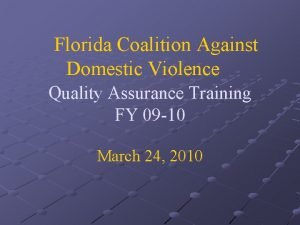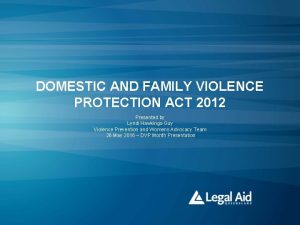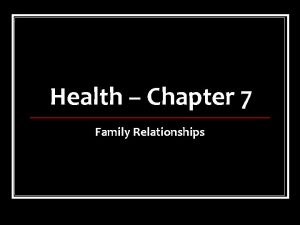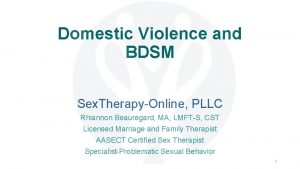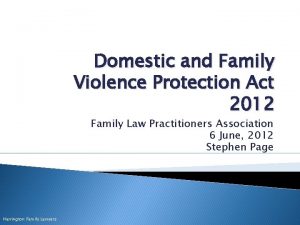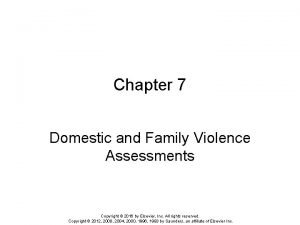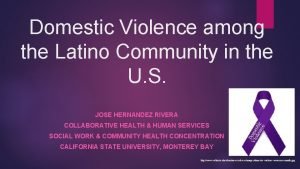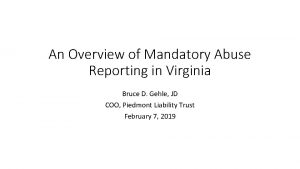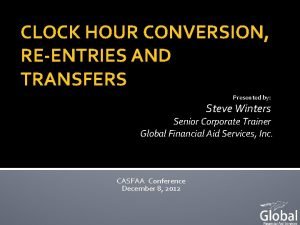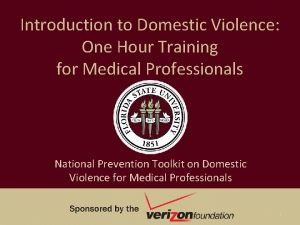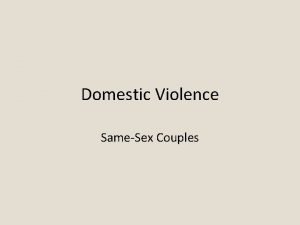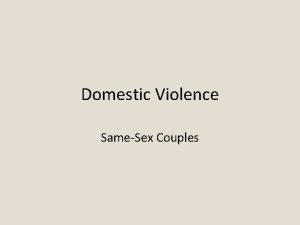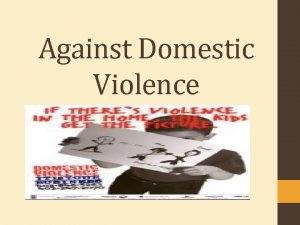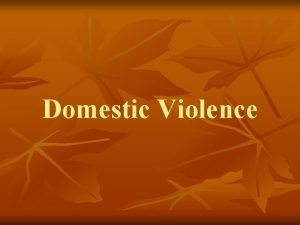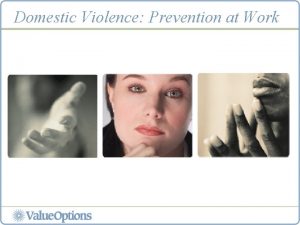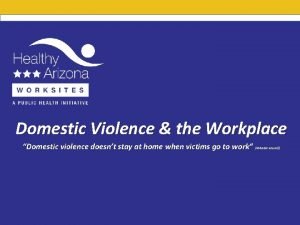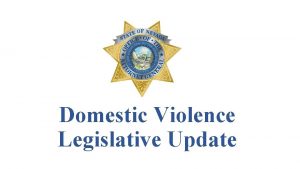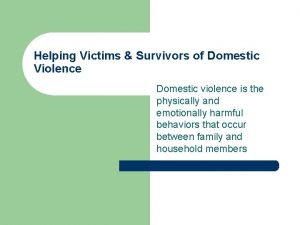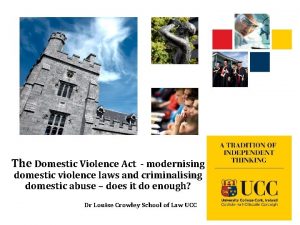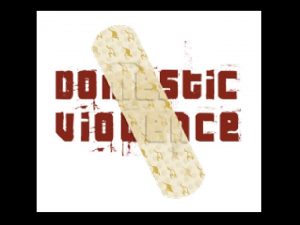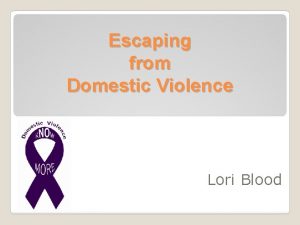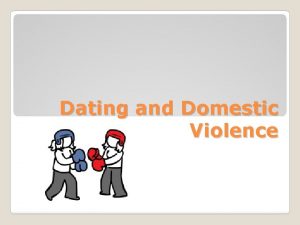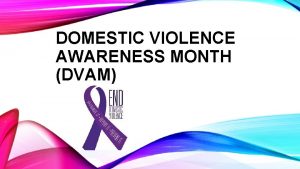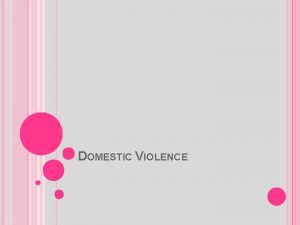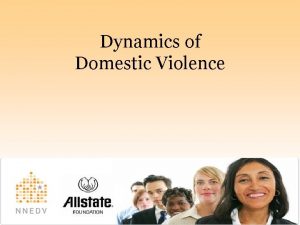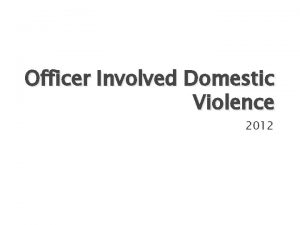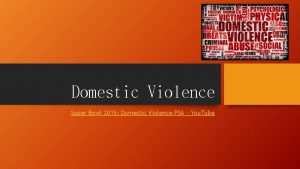Introduction to Domestic Violence One Hour Training for










































- Slides: 42

Introduction to Domestic Violence: One Hour Training for Medical Professionals National Prevention Toolkit on Domestic Violence for Medical Professionals 1

Overview • This training educates medical professionals about the dynamics and impact of domestic violence. We use the term “domestic violence” to refer to the following: - Interpersonal Abuse - Relationship Abuse - Dating Violence - Domestic Abuse • Domestic violence is an epidemic in the United States that is not only pervasive, but also extremely costly in human and financial capital. • It is a serious public health problem that can be prevented. 2

Overview (continued) • It affects victims, as well as families, children, friends, and communities. • Victims are affected physically, as well as mentally, during and after abuse. • Providing victims with information and connection to resources in the community can help prevent further abuse. • Every medical professional will encounter victims of domestic violence. 3

Objectives After completing this training, medical professionals will be able to do the following: • Understand the dynamics and impact of domestic violence. • Know the prevalence and incidence of domestic violence in the United States. • Recognize batterer behaviors. • Be aware of the risk factors among perpetrators and victims. 4

Objectives (continued) • Understand the physical and mental health consequences of domestic violence. • Understand some of the reasons why victims stay. • Learn ways to become part of the solution to end domestic violence in your community. • Understand myths associated with domestic violence. • Understand interventions to help domestic violence victims. 5

State Laws • Every state defines domestic violence differently, pursuant to code or statute. • Every medical professional should be familiar with the state laws regarding domestic violence and any mandatory reporting laws. View our Resource Page for a list of state laws about domestic violence. www. dvmedtraining. csw. fsu. edu/resources 6

What is domestic violence? A descriptive, non-legal definition of domestic violence is: “the pattern of abusive behavior in any relationship that is used by one partner to gain or maintain power and control over another partner. ” – It can happen to anyone regardless of race, age, education level, sexual orientation, occupation, religion, or gender. – Domestic violence can occur in an intimate, co-habiting, dating, engagement, marriage, post-separation, or postdivorce relationship. – Some domestic violence acts are not considered crimes on their own, but all contribute to a pattern of behavior that seeks to control victims. 7

The Public Health Crisis of Domestic Violence According to the US Centers for Disease Control: • 24 people per minute are victims of rape, physical violence, or stalking. • More than 1 in 3 women and 1 in 4 men have experienced rape, physical violence, and/or stalking by an intimate partner. • 1 in 10 women have been raped by an intimate partner. • 1 in 4 women experience severe physical violence. • 10. 7% of women are stalked by an intimate partner. 8

The Public Health Crisis of Domestic Violence (continued) • Nearly half of all female victims are psychologically abused. • 3 in 10 women who have experienced rape, physical violence, and/or stalking reported at least 1 impact: • Fear, concern for safety, PTSD, need for health care, injury, contacting crisis hotline, need for housing, advocate services, legal services, missed work or school. • Victims of severe domestic violence collectively lose nearly 8 million days of paid work. • In 2010 1, 095 women were murdered by an intimate partner. 9

The Financial Cost of Domestic Violence • In 2003 alone, the cost for medical and mental health services and lost productivity was equal to 8. 3 billion dollars – Cost of rape = $460 million – Cost of stalking = $461 million – Cost of lives lost = $1. 2 billion – Cost of physical assault = $6. 2 billion • These costs are probably much greater because domestic violence is a chronically underreported crime. 10

Affects on Children Who Witness Domestic Violence • • Below are statistics on how many children are affected by domestic violence: Each year an estimated 3. 3 million children are exposed to violence against their mothers or female caretakers. The number-one predictor of child abuse is domestic abuse of women. Studies indicate that child abuse occurs in 30 to 60 percent of homes where domestic violence occurs. Victim advocates agree: the key to keeping children safe is to keep their victimized parent safe. 11

Affects on Children Who Witness Domestic Violence (continued) • Children have different coping mechanisms and resiliency skills that impact how they are affected by domestic violence. • However, the APA states that overall, children who witness domestic violence often: – Live in constant fear for themselves and abused parents. – Are affected in similar ways to children who are physically abused. – Are more likely to develop social, emotional, psychological, or behavioral problems which can continue into adulthood. 12

Rebutting Myths It is important to be able to distinguish between myths and facts about domestic violence. Myths Facts “She deserved it. ” No one deserves to be punished with abuse. “You can’t rape a significant other. ” Even if someone is your significant other, consent is always needed. “I was teaching her a lesson. ” Abuse is never a lesson. “I was drunk/high, I didn’t know what I was doing. ” Alcohol and drugs do not cause someone to be abusive. It is only a risk factor and can make abuse more lethal. “They’re gay/lesbians, so it’s not domestic violence. ” Violence can occur in all types of relationships, regardless of gender or sexual identity. 13

Rebutting Myths (continued) Myths Facts “Women are just as likely to be abusers. ” Some women do commit domestic violence. However, men abuse their partners at a much higher rate. Women are also more likely to be seriously injured, stalked, experience sexual violence, and be murdered by male partners. “It was one isolated incident. ” One time is too many times, and abusers often plead forgiveness, only to repeat violence. “If it were so bad, she would leave. ” Victims do not always have the resources or support to leave a dangerous situation or are afraid of the consequences. “Mental illness causes domestic violence. ” Being abusive is not a mental illness, it is a choice. While abusers and victims may have a mental illness, it is not an excuse for violence perpetration or victimization. 14

Abuser Behaviors • Abusers use violence and threats to establish power and control over their partners through fear and intimidation. • The abuser’s pattern of abusive acts is used to gain control and compliance of the victim. • The tactics are selectively chosen and purposeful. • It is impossible to appease abusers. They never have enough control over their victims. 15

Different Types of Domestic Violence Domestic violence often encompasses many different types of abuse. The violence can include: o o o Physical Abuse Sexual Abuse Verbal Abuse Financial Abuse Stalking The abuser uses whatever works to assert power and control through fear and intimidation. 16

Physical Abuse Physical abuse is the intentional use of physical force with the potential for causing injury, harm, disability, or death. • • • Punching, Slapping, and Hitting Kicking, Cutting, and Stabbing Weapon Use Biting, Scratching, and Burning Pushing and Shoving Restraining, Strangling, and Holding Down 17

Psychological/Emotional Abuse Psychological or emotional abuse is any behavior that threatens, intimidates, undermines the victim’s self-worth or self-esteem, or controls the victim’s freedom. • • Humiliation Isolation Degradation Diminishing self-worth and self-esteem Control of victim behavior Blackmail Intimidation 18

Sexual Abuse Sexual abuse is the use of physical force, coercion, or threats to force a person to have sex against his or her will. • • • Rape and sexual assault Forcing the victim to watch or create pornography Forced pregnancy Forced anal or oral sex Unwanted touching Reproductive coercion 19

Defining Sexual Assault and Rape Sexual assault is the most inclusive term that includes sex-related behaviors from unwanted sexual contact through sexual intercourse. Rape refers to some form of bodily penetration. – – – Vaginal rape Anal rape Digital rape Oral rape Use of an object to penetrate Check your state’s individual laws for more information. 20

Economic/Financial Abuse Economic abuse occurs when an abuser controls finances and the victim’s ability to obtain money or control over his or her finances. • Preventing the victim from having or keeping a job • Interfering with the victim’s efforts to maintain a job – Sabotaging childcare, transportation, or other arrangements • Harassing the victim at work • Refusing to work • Not allowing the victim access to the family finances • Taking the victim’s money • Demanding an account of everything the victim buys • Controlling the victim’s access to financial information • Not allowing the victim’s name to be on accounts • Not allowing the victim to obtain health insurance, Medicare, welfare, disability, etc. 21

Verbal Abuse Verbal abuse is the perpetrator humiliating and threatening the victim. • Degrading the victim in front of friends and family • Telling hurtful “jokes” despite the victim’s requests to stop • Taking the victim’s statements out of context • Name calling • Insulting • Humiliation Criticizing Blaming Accusing Questioning the victim’s sanity • Threats of physical abuse • Coercing or forcing the victim to do things he or she does not want to do. • • 22

Stalking • Stalking is harassing or threatening behavior that an individual engages in repeatedly. • Stalking can be carried out in person or via electronic mechanisms. • Types of stalking behaviors include: – Following a person – Appearing uninvited at a victim’s home or work – Harassing phone calls, text messages, and electronic messages – Vandalizing property – Giving constant unwanted gifts, messages, flowers, etc. , to convince the victim to forgive or return to the abuser. 23

Cyber-stalking is the use of technology to stalk victims. It involves the pursuit, harassment, or contact of a victim in an unsolicited way initially via the internet and electronic devices. Cyber-stalking may be used through: • Email: Constant emails harassing the victim • Chat rooms: Constant bombarding of messages • Social networking sites (Facebook, Twitter, Instagram): Following what the victim is saying, doing, and places he or she is visiting and sending repeated unwanted messages • GPS System (On-Star): Following the victim through access of his or her GPS • Portraying the Victim: Assuming the victim’s identity to portray him or her in a negative light online 24

Common Characteristics of Abusers Medical professionals should know the following: • Most abusers are not mentally ill. • Abuse is not caused by anger management problems or stress. • Abusers deny responsibility of abuse and often blame the victim for the abuse. • Abusers choose to abuse victims. Although abusers may have a substance abuse issue or have been abused in the past, this does not cause abuse. 25

Common Characteristics of Victims Research has indicated that victims of domestic violence may demonstrate one or more of the following characteristics: • Many victims feel helpless and cannot safely leave an unhealthy relationship. • Many victims have been shamed or embarrassed about abuse, and keep it a secret to protect themselves. • Many victims fear for the safety of themselves, but also their children, family members, pets, and belonging. 26

Domestic Violence: Often About Power and Control • Battering is one form of domestic violence that is characterized by the pattern of actions that someone uses to control or dominate his or her partner. – The abuser systematically uses threats, intimidation, and coercion to create fear. These behaviors are the spokes of the wheel. • Physical and sexual violence are what holds the wheel together, creating the rim of the wheel. 27

Consequences of Domestic Violence affects people and changes them forever. The most immediate feelings following domestic violence are a sense of helplessness, anger, anxiety, depression, and fear. Domestic violence can cause very serious health and mental health consequences. A few of the most common consequences are listed below. • Health – Injuries to extremities • Broken bones, cuts, scratches, bruises, strangulation marks – – – Chronic pain Gastrointestinal problems Chest pain Gynecological problems Poor pregnancy outcomes • Mental Health – – – Anxiety Depression PTSD Chronic Stress Alcohol/Drug abuse For more information on negative physical and mental health conditions related to domestic violence, see the Basics of Screening Training at nationaltoolkit. csw. fsu. edu/medicalprofessionals/screening 28

• Why Some Victims Stay with Abusers Fear of Further Violence Victims may fear that: – There will be more abuse – The abuser may carry out threats to kill – The abuser may destroy her belongings – Her reputation will be ruined • Isolation and Lack of Resources Victims may have: – – – No money or income No safe place to go to Few people to ask for help No transportation No ability to leave – The abuser may harm children, pets, and other family members – She won’t be able to see children – The abuser may kill the victim or him/herself The most dangerous time for a woman is immediately after leaving an abuser. Her risk of serious injury or death is highest at this time, when the abuser does not have access to her. 29

Why Some Victims Stay with Abusers • Lack of Support: – – No friends or family to turn to Ashamed or embarrassed to ask for help Afraid of being alone Worry that they won’t be believed • Beliefs and Feelings: – – – Feel responsible for abuse Love the abuser Have children with the abuser Religious or social beliefs that divorce is wrong Religious or social beliefs that must obey and support the man 30

Victim Coping Mechanisms • Minimizing: Downplaying the importance or severity of abusive behaviors • Denial: Refusing to admit or pretends that abuse is not happening • Rationalization: Victims find reasonable explanations for the abuser’s behavior • Stress, work, lack of sleep • Drug/Alcohol Use: Numb the pain from abuse • Self Blame: Blame themselves for the actions of the perpetrators 31

Avoiding Negative Reactions to Victims Who Don’t Leave • Many professionals who interact with victims become frustrated with victims. • They think victims are putting themselves in a dangerous situation and being reckless. • Medical professionals may suggest that the victim leave the abuser and when he or she doesn’t, consider him or her noncompliant. • Victims may not leave for a multitude of reasons, including that they do not know the resources available to them or are afraid of what could happen if they are caught. 32

Why Blaming the Victim is Wrong • People blame victims to distance themselves from domestic violence so they feel more in control of their own safety. • The problem of victim blaming is that it marginalizes the victim and makes it harder to come forward and report the abuse. • Victim-blaming attitudes also reinforce what the abuser has been saying to the victim: that it is the victim’s fault. • Victim blaming allows the abuser to perpetrate the victim while avoiding accountability. • It is NEVER the victim’s fault. It is always the abuser’s choice to take advantage of another human being. 33

Prevention of Domestic Violence For medical professionals, preventing domestic violence includes educating patients about is and helping victims access resources to help stop it. 34

Prevention: What Medical Professionals Can Do Medical professionals can help victims of domestic violence by: • Screening patients for domestic violence. – Many medical associations have recommended screening patients for domestic violence, including the following: The American Medical Association, the American Academy of Family Physicians, American Academy of Neurology, American College of Emergency Physicians, American College of Nurse-Midwives, American College of Obstetricians and Gynecologists, American Nurses Association, American Public Health Association, Emergency Nurses Association, American Medical Association, American Dental Association, and the American Academy of Orthopaedic Surgeons Please view the training “Screening Patients for Domestic Violence” to learn more about the importance of screening. 35

Prevention: What Medical Professionals Can Do (continued) Medical professionals can help victims of domestic violence by: • Understanding the definition and dynamics of domestic violence • Explaining to all patients that no one deserves to be abused • Providing all patients with information about community resources • Understanding why victims may stay with their abusers and why this does not mean they are noncompliant with professional requests • Understanding how to screen patients for domestic violence victimization • Learning how to follow up with patients who are victimized by their partners • Knowing the resources available in the community so that they can be recommended to help victims • Evaluating your own attitudes on abuse and how you feel and think about victims and abusers 36

Community Resources Shelters: Place of temporary refuge and support for women escaping violent or abusive situations How Medical Professionals Can Help • • • Become familiar with shelters in your community. Obtain a contact of an advocate at the shelter. Connect patients directly with the advocate. Injunctions: Court orders that require a party to do or refrain from doing specific acts • Connect patients with someone who can assist them in the injunction process (usually an advocate or a police department or agency) Crisis Intervention: Emergency psychological care to assist individuals in a crisis situation to restore balance to their biopsychosocial functioning • Become familiar with crisis hotlines in your area. • Provide information to patients on these services and allow them to call when and if they are ready. 37

Resources How Medical Professionals Can Help Advocacy: Provide a range of supportive services to help individuals involved in domestic abuse situations to become self-sufficient • Connect patients with advocates in the community, through hotlines, or in your own medical facility. • Advocates can include domestic violence workers, counselors, social workers, psychologists, etc. Safety Plan: Coming up with a detailed plan on how to leave an abuser safely • Connect patients with a shelter advocate or domestic violence hotline advocate to help plan. Law Enforcement: Some victims may seek the assistance of law enforcement. • Talk with patients about the option of calling law enforcement. • Do not force patients to report abuse. • If you are a mandatory reporter, let patients know if you will be contacting law enforcement. 38

The National Domestic Violence Hotline If you or a patient have any questions about domestic violence, or need help, call: 1 -800 -799 -7233 39

Conclusion • Domestic violence can affect anyone, no matter their gender, race, ethnicity, sexual orientation, or socioeconomic background. • It is a preventable health problem. • Medical professionals should be willing and able to take steps to inform patients about domestic violence and community resources to address it. 40

References • Family Violence Across the Lifespan – Barnett, O. W. , & Perrin, R. D. (2011). Family violence across the lifespan: An introduction (3 rd ed. ). Los Angeles, CA: Sage Publications, Inc. • Family Violence: Legal, Medical, and Social Perspectives – Wallace, H. (1996). Family violence: Legal, medical, and social perspectives (6 th ed. ). Boston: Allyn and Bacon. • DV 101: Dynamics of Domestic Violence – http: //training. familyvio. csw. fsu. edu/manuals/dv 101/index. php? content=index • Futures Without Violence – http: //www. futureswithoutviolence. org/content/action_center/detail/754 • Center for Disease Control: Intimate Partner Violence – http: //www. cdc. gov/violenceprevention/intimatepartnerviolence/index. html • Center for Disease Control: Fact Sheet – http: //www. cdc. gov/violenceprevention/pdf/ipv_factsheet 2012 -a. pdf • NISVS 2010 Summary Report – http: //www. cdc. gov/violenceprevention/pdf/nisvs_executive_summary-a. pdf • National Coalition Against Domestic Violence – http: //www. ncadv. org/protectyourself/My. Personal. Safety. Plan_131. html • Center for Relationship Abuse Awareness – http: //stoprelationshipabuse. org/educated/types-of-abuse/sexual-abuse/ 41

You Have Completed the Basic Training! 42
 Florida coalition against domestic violence
Florida coalition against domestic violence Domestic and family violence protection act 2012
Domestic and family violence protection act 2012 Chapter 7 family relationships
Chapter 7 family relationships Domestic violence kink
Domestic violence kink Domestic and family violence protection act 2012
Domestic and family violence protection act 2012 Chapter 7 domestic and family violence assessment
Chapter 7 domestic and family violence assessment Domestic violence in the hispanic community
Domestic violence in the hispanic community Virginia mandatory reporting law domestic violence
Virginia mandatory reporting law domestic violence 24 hour time to 12 hour time
24 hour time to 12 hour time Clock hour to credit hour conversion
Clock hour to credit hour conversion Introduction to domestic wiring
Introduction to domestic wiring Personally identifiable information pii training 1 hour
Personally identifiable information pii training 1 hour One empire one god one emperor
One empire one god one emperor Little dog run
Little dog run One king one law one faith
One king one law one faith One empire one god one emperor
One empire one god one emperor Ford one plan
Ford one plan See one do one teach one
See one do one teach one See one, do one, teach one
See one, do one, teach one Willow cabin speech
Willow cabin speech See one do one teach one
See one do one teach one Asean tourism strategic plan
Asean tourism strategic plan Graphic organizer with the aims of la liga filipina
Graphic organizer with the aims of la liga filipina Why minute has 60 seconds
Why minute has 60 seconds 1 hour asl
1 hour asl Violent one hour
Violent one hour Iso 22301 utbildning
Iso 22301 utbildning Novell typiska drag
Novell typiska drag Nationell inriktning för artificiell intelligens
Nationell inriktning för artificiell intelligens Ekologiskt fotavtryck
Ekologiskt fotavtryck Varför kallas perioden 1918-1939 för mellankrigstiden
Varför kallas perioden 1918-1939 för mellankrigstiden En lathund för arbete med kontinuitetshantering
En lathund för arbete med kontinuitetshantering Personalliggare bygg undantag
Personalliggare bygg undantag Personlig tidbok
Personlig tidbok Sura för anatom
Sura för anatom Densitet vatten
Densitet vatten Datorkunskap för nybörjare
Datorkunskap för nybörjare Boverket ka
Boverket ka Debatt artikel mall
Debatt artikel mall Magnetsjukhus
Magnetsjukhus Nyckelkompetenser för livslångt lärande
Nyckelkompetenser för livslångt lärande Påbyggnader för flakfordon
Påbyggnader för flakfordon Formel för lufttryck
Formel för lufttryck
